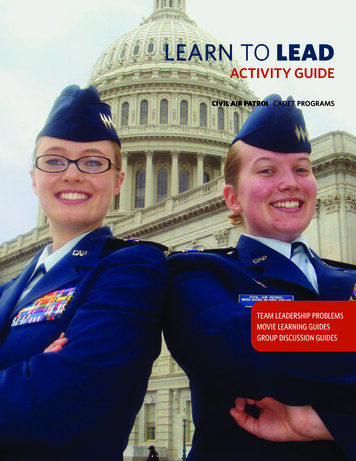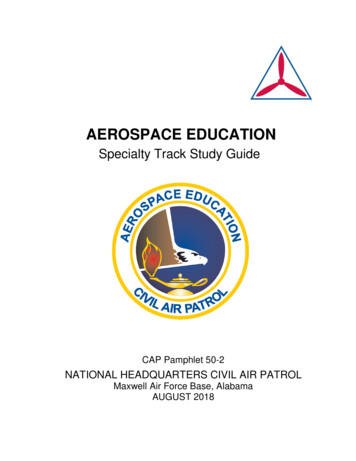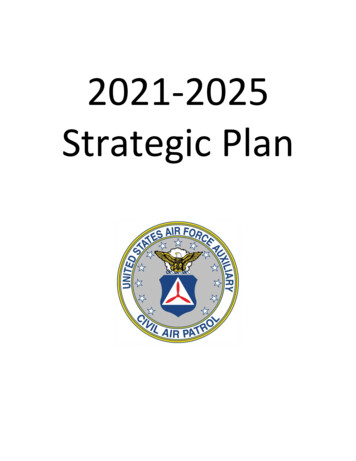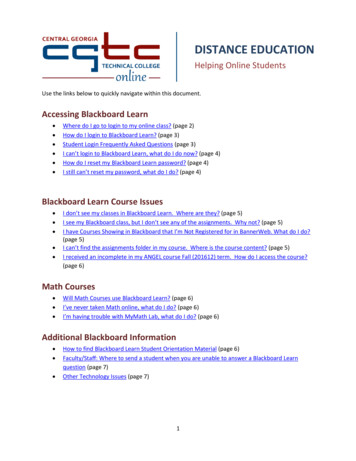
Transcription
LEARN TO LEADACTIVITY GUIDECIVIL AIR PATROL CADET PROGRAMSTEAM LEADERSHIP PROBLEMSMOVIE LEARNING GUIDESGROUP DISCUSSION GUIDES
PrefaceLEARN TO LEAD ACTIVITY GUIDEDo you learn best by reading? By listening to a lecture? By watching someone at work? Ifyou’re like most people, you prefer to learn by doing. That is the idea behind the Learn to LeadActivity Guide. Inside this guide, you will find: Hands-on, experiential learning opportunitiesCase studies, games, movies, and puzzles that test cadets’ ability to solveproblems and communicate in a team environmentRecipe-like lesson plans that identify the objective of each activity, explain how toexecute the activity, and outline the main teaching pointsLesson plans are easy to understand yet detailed enough for a cadet officer or NCOto lead, under senior member guidanceThe Activity Guide includes the following: 24 team leadership problems — Geared to cadets in Phase I of the Cadet Program, eachteam leadership problem lesson plan is activity- focused and addresses one of the followingthemes: icebreakers, teamwork fundamentals, problem solving, communication skills,conflict resolution, or leadership styles. Each lesson plan includes step-by-step instructions onhow to lead the activity, plus discussion questions for a debriefing phase in which cadetssummarize the lessons learned. 6 movie learning guides — Through an arrangement with TeachWithMovies.com, the Guideincludes six movie learning guides that relate to one or more leadership traits of Learn to Lead:character, core values, communication skills, or problem solving. Each guide includesdiscussion questions for a debriefing phase in which cadets summarize the lessons learned.These copyrighted lesson plans are used with permission of TeachWithMovies.com, thepremier site on the Internet showing teachers and parents how to use feature length films tosupplement curriculum, foster social-emotional learning, and teach ethics. CAP encouragesits members to subscribe to their database of over 300 movie learning guides. References to“The Six Pillars of Character” are from CharacterCounts.org. 6 group discussion guides — Each group discussion lesson plan addresses one of the majorsections of the "Learn to Lead" textbook, explaining an abstract concept through the guideddiscussion method. There are two lessons per chapter.1
CONTENTSPart 1TEAM LEADERSHIP PROBLEMSICEBREAKERSCommon CandyTime for the ShoeA Star is BornNot TrueTEAMWORK FUNDAMENTALSOh, SnapPuzzle Me ThisThe EssaySpider Web34567891011PROBLEM SOLVINGMind GamesThe RingEqual DistributionOne Thing is Like Another12131415COMMUNICATION SKILLSThe GameI Know YouMy CommunityIt’s All in the Cards16171819CONFLICT RESOLUTIONSuits MeBending the RulesIt’s Me, Not YouNot Me20212223LEADERSHIP STYLESLand MinesLeadership From a HatWhich Way Did I Go?Monte Carlo24252627Part 2MOVIE LEARNING GUIDES29GettysburgApollo 13The Longest DayMr. Holland’s OpusFail SafeThe Right Stuff304146505666Part 3GROUP DISCUSSION GUIDES73Character CountsAir Force TraditionsSelf-ManagementTeamworkThe Role of the LeaderGreat Man Theory747678828589LEARN TO LEAD ACTIVITY GUIDEPublished by Civil Air PatrolMaxwell Air Force Base, ALCopyright 2009Developed byRob Smith2
Part 1TEAM LEADERSHIP PROBLEMS33
TEAM LEADERSHIP PROBLEM1.COMMON CANDYTheme: IcebreakersEstimated Time: 25-30 minutesResources Required: One large bag of peanut M&Ms or any colored candy.Activity Description and Step-by-Step Instructions:One of the best ways to get to know your fellow teammates is to find out what you have incommon. Distribute one M&M to every person. State, “Don’t eat the candy just yet. Instead, Ineed everyone to group together by the color of their candy.”Once the groups are assembled, state, “Your task is to learn something about the others inyour group that you all have in common.” Allow 2-3 minutes for discussion, and then state,“OK, it’s time to share.” Ask each group to tell you what they have in common. Let the groupseat their candy, if they desire.Distribute another piece of candy to every person. Arrange the groups by candy color again.State, “This time, find out something about the others in your group that you all have incommon, but it can’t be anything related to CAP.” Allow 3-4 minutes for discussion, and thenstate, “OK, it’s time to share.” Ask each group to tell you what they have in common. Let thegroups eat their candy, if they desire.Distribute another piece of candy to every person. Arrange the groups by candy color again.State, “This time, find out what hobbies the others in your group enjoy other than anythingCAP related.” Allow 3-4 minutes for discussion, and then state, “OK, it’s time to share.” Askeach group to tell you what they have in common. Let the groups eat their candy, if theydesire.Discussion Questions:What did we just do?What did you learn?What were some leadership concepts learned from this exercise?How can these leadership concepts be applied to outside this activity?4
TEAM LEADERSHIP PROBLEM2.TIME FOR THE SHOETheme: IcebreakersEstimated Time: 25-30 minutesResources Required: NoneActivity Description and Step-by-Step Instructions:A good way to break the ice with a group is to place everyone in the same situation and havethem try to solve the matter together.Instruct everyone to take off one shoe and to line them up against a wall. Then have everyonesit back down. State that this is a silent exercise. Then instruct one person at a time to go upto the line of shoes and pick a shoe that is not theirs and try to match it with the owner. Aftereveryone has the opportunity to try to correctly match the shoes, ask the group if they weresuccessful. If not, repeat until all shoes match. {Watch for non-verbal clues that the studentsgive throughout}.Discussion Questions:What did we just do?What did you learn?What were some leadership concepts learned from this exercise?How can these leadership concepts be applied to outside this activity?5
TEAM LEADERSHIP PROBLEM3.A STAR IS BORNTheme: IcebreakersEstimated Time: 25-30 minutesResources Required: Roll of toilet paperActivity Description and Step-by-Step Instructions:A great way to see some smiles is to use toilet paper in a unique way! This activity getseveryone involved.Have everyone stand in a circle facing each other. Toss the toilet paper roll to someone andstate that the group needs to unroll the toilet paper to everyone else without tearing. Anytears, and the process starts over.Once the group has successfully made a circle with the toilet paper, instruct them to make afive pointed star without tearing. Any tears, and the process starts over. Allow the group tocommunicate verbally, but once someone has made a suggestion or instruction, he or shemust remain silent until everyone else has made a suggestion or instruction.Continue until the group successfully makes a star without tearing or 15 minutes haveelapsed, whichever comes first.Discussion Questions:What did we just do?What did you learn?What were some leadership concepts learned from this exercise?How can these leadership concepts be applied to outside this activity?6
TEAM LEADERSHIP PROBLEM4.NOT TRUETheme: IcebreakersEstimated Time: 25-30 minutesResources Required: Deck of cardsActivity Description and Step-by-Step Instructions:Is it easy to tell when someone is lying, especially since you don’t really know the person?This activity explores how easy it may be to deceive others while getting to know them.Thoroughly shuffle a deck of cards and allow everyone to select one card. Instruct the groupmembers not to reveal their cards to others. Everyone is to think of three facts aboutthemselves.Instruct those with a face card (ace, king, queen or jack) to think of two facts aboutthemselves that are true, and one that is false.Instruct those with a joker, if any, to come up with three facts about themselves that are allfalse.All other cards are to have three true facts about themselves.Instruct everyone to share their facts and to keep track of who they think has a face card orjoker.Compare notes to see if the group correctly guessed those with face cards or jokers.Discussion Questions:What did we just do?What did you learn?What were some leadership concepts learned from this exercise?How can these leadership concepts be applied to outside this activity?7
TEAM LEADERSHIP PROBLEM5.OH, SNAPTheme: Teamwork FundamentalsEstimated Time: 25-30 minutesResources Required: Pack of paper plates, tape, snaps (little, white-wrapped fireworks thatmake snapping noise when thrown on ground or stepped on), open flat area like a gym orparking lot, stopwatch (optional)Activity Description and Step-by-Step Instructions:Being responsible for others is part of being a team. This exercise helps to model thisattribute.Find an open, flat area (about the size of a volleyball court; hard surface works best). Markthe boundaries; using lines on the gym floor or parking lot lines are fine.Tape snaps to the top of 1/4 of the paper plates. Place them randomly within the establishedboundaries upside down so the Snaps do not show. Place the rest of the plates in the samefashion within the established boundary. Plates should be spaced so participants can easilystep from one to another.Have the group break into teams of 4 or 5. State to the teams that the plates representstepping stones. Participants must step from one plate to another in order to cross from oneside of the playing area to the other while remaining within the boundaries. The plates withthe taped snaps are “mined.”When a participant steps on a “mined” plate they are “injured” and a team member mustcome to their aid. That rescuer must find a way to carry their “injured” team member. If bothstep on another “mine,” they both must start over.The stopwatch will help if a team wants to know how long it takes to accomplish the task.Discussion Questions:What were some methods used that worked or did not work?What were some ways to make the team work more efficiently?What were some concepts learned from this exercise?How can these concepts be applied to outside this activity?8
TEAM LEADERSHIP PROBLEM6.PUZZLE ME THISTheme: Teamwork FundamentalsEstimated Time: 25-30 minutesResources Required: A puzzle from a dollar store (try to find one with about 100 pieces).Activity Description and Step-by-Step Instructions:Leaders must be flexible. They must be able to delegate responsibility to others and even toplace others in command if they become incapacitated. This exercise helps to model theseattributes.Prepare the puzzle box ahead of time by removing the corner pieces (you keep these with youduring the activity), and by removing any end pieces (separate these into four plasticbaggies). Leave the rest of the puzzle pieces in the box.Instruct the group that it will be putting together the puzzle and give it the box. Allow them tobegin and keep track of who leads. Pick someone who is not leading and hand him or her oneof the baggies containing some of the edge pieces. State that this person is now the leader.After a few minutes, pick out another person who has not led. Give this person another baggieof edge pieces and declare that person the leader. Continue this cycle until all baggies havebeen given out and the puzzle is completed (minus the corner pieces, of course). Show thegroup that you had the corner pieces all along and that this activity was not really aboutsolving the puzzle. Ask the group, “What do you think this activity was about?”Discussion Questions:What were some methods used that worked or did not work?What were some ways to make the team work more efficiently?What were some concepts learned from this exercise?How can these concepts be applied to outside this activity?9
TEAM LEADERSHIP PROBLEM7.THE ESSAYTheme: Teamwork FundamentalsEstimated Time: 25-30 minutesResources Required: Paper, pen or pencilActivity Description and Step-by-Step Instructions:It’s true that together everyone accomplishes more (TEAM). This activity will visually showthis truism.State that the purpose of this activity is to show that the acronym TEAM means “togethereveryone accomplishes more.” Ask everyone to think of a leader whom they admire and towrite in one sentence why this person is a good leader.Divide the group into four equal teams. Have each team combine their sentences to form oneparagraph about leadership.After about 10 minutes, bring the group back together. Gather each paragraph and tape themto the wall or whiteboard so that they make a completed essay. Title the essay, “Our Group’sView on What Makes for a Good Leader.” Ask someone to read the completed essay to thegroup.Discussion Questions:What were some methods used that worked or did not work?What were some ways to make the team work more efficiently?What were some concepts learned from this exercise?How can these concepts be applied to outside this activity?10
TEAM LEADERSHIP PROBLEM8.SPIDER WEBTheme: Teamwork FundamentalsEstimated Time: 25-30 minutesResources Required: A ball of yarnActivity Description and Step-by-Step Instructions:It’s amazing how quickly a team can get into a mess and how long it takes to get out of it!This activity visually illustrates this point.Have everyone stand in a circle and face each other. State that it’s amazing how quickly ateam can get into a mess and how long it can take to get out of it. Throw the ball of yarn to aperson in the circle, allowing the yarn to unravel. State that this person needs to hold on to theend of the string, then throw the yarn to someone else who is not near them. Repeat untileveryone is hanging onto the yarn and a tangled web is in the middle.Instruct everyone to hold onto the yarn and to work together to unravel the web. Stop after 15minutes or when the group completes the activity, whichever comes first.Discussion Questions:What were some methods used that worked or did not work?What were some ways to make the team work more efficiently?What
LEARN TO LEAD ACTIVITY GUIDE Do you learn best by reading? By listening to a lecture? By watching someone at work? If you’re like most people, you prefer to learn by doing. That is the idea behind the Learn to Lead Activity Guide. Inside this guide, you will find: Hands-on, experiential learning opportunities Case studies, games, movies, and puzzles that test cadets’ ability to .File Size: 1MBPage Count: 94











